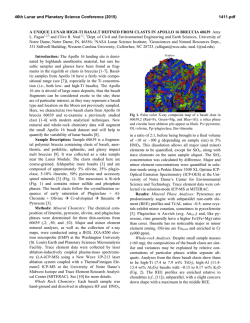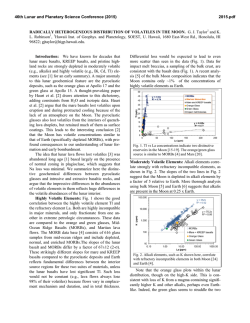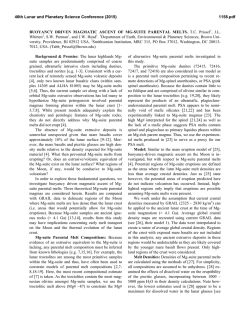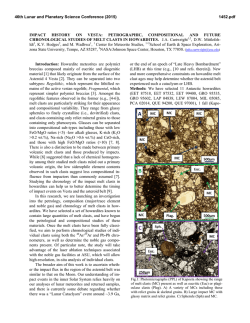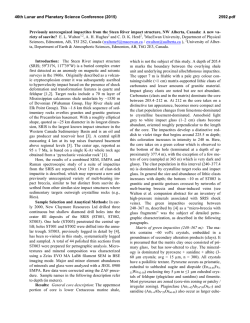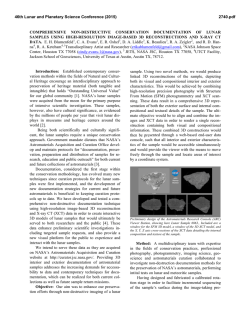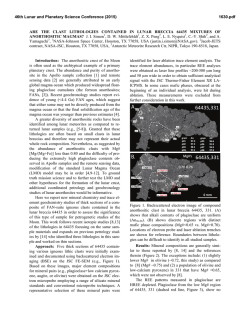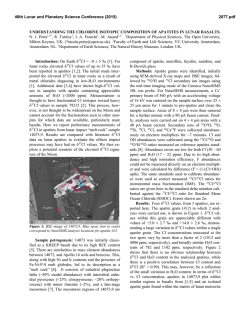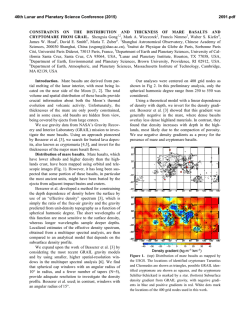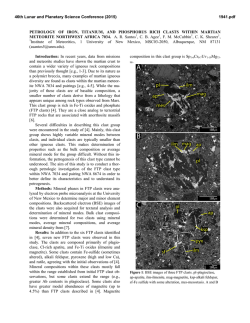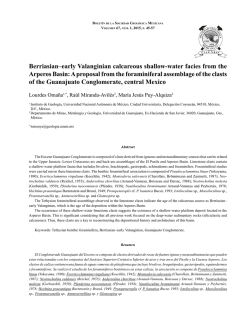
APOLLO 17 KREEP: NEW DATA ON 72275 BASALTS USING
46th Lunar and Planetary Science Conference (2015) 1298.pdf APOLLO 17 KREEP: NEW DATA ON 72275 BASALTS USING EPMA, ICPMS, AND QUANTITATIVE PETROGRAPHY. K Cronberger1 and C. R. Neal1, 1Dept. Civil Eng. & Env. Eng. & Earth Sci., University of Notre Dame, Notre Dame, IN 46556, USA [[email protected]; [email protected]]. The current state of research suggests that impact and endogenous melting models seem to be correct for different groups of samples. For example, Apollo 14 Introduction. The lunar “KREEP” component is KREEP-rich basalts are hypothesized to be impact hypothesized to represent the last ~0.5% of liquid generated (e.g., [6]), where those found at Apollo 15 remaining by the crystallization of the Lunar Magma are considered to be pristine melts of the lunar interior Ocean (e.g., 1,2]). It is represented in the lunar sample (e.g., [5,7]). collection as basaltic materials and plutonic rocks that have been contaminated by KREEP. KREEPy basaltic rocks fall into 2 categories: pristine melts of the lunar interior (either with KREEP in the source region or being assimilated during magma migration); and impact melts. Differentiation between these is not easy. KREEP basalts from Apollo 17 are distinctive from those returned by Apollo 14 and 15 (Fig. 1; [3]). They are represented by the basaltic samples in breccia 72275, have a whole rock pattern that is flatter in the light REE and steeper in the heavy REE (Fig. 1) relative to other KREEP samples. Do these samples represent impact mixtures or endogenous melts of the lunar interior? Salpas et al. [1] concluded that the 72275 basalt samples represented endogenous melts related through crystal fractionation of olivine and low-Ca pyroxene. We propose to test this hypothesis. The traditional method for identifying impact melts is by quantifying the abundances of Highly Sidirophile Elements (HSE), as these are generally enriched in HSE’s when compared to pristine lunar materials [2]. Such analyses require the destruction of a relatively large amount of material, which is often not possible, especially when these samples are small breccia clasts. Qualitative petrographic methods have also been used to identify pristine KREEP basalts [3], although this method is not without error [4]. Figure 2: A: Photomicrograph (XP) of 72275,136. B: PPL image of 72275,136. Basalt clasts yellow outline), and a large brecciated clast (blue outline) are present. Basalt clasts within a brecciated clast can be seen. Photmicrograph = 12mm across. C: Element map: Fe = Red, Ca = Green, Mg = Blue. A and B are 5.5 mm across, C is 4.5 mm across. Apollo 17 KREEP basalts are uniquely found in breccia 72275 [3]. Basalt clasts are found within other clasts (Fig. 2). This clast-within-a-clast breccia would require several impact events to achieve this result [3]. 46th Lunar and Planetary Science Conference (2015) In 72275, the KREEP basalt clasts and the groundmass were compositionally similar, as were the veins of melted material traversing both. 72275,136 is a thin section of a basaltic micro breccia with several basalt clasts, ranging in size from 1-3mm. The brecciated material is made up of pyroxene, plagioclase, ilmenite, olivine, and mesostasis fragments [1]. The basalt clasts consist primarily of pigeonite and plagioclase with minor ilmenite, and rare olivine. The pyroxenes areintergrown with plagioclase, similar to the observations of 15434,188 [4] and 15434,181 [5]. Basalt clasts in 72275 are often grouped near each other, and at times, are found as a part of a distinct large brecciated clast (see Fig. 2) within 72275. Or in another way, the Russian Nesting Doll of Moon rocks (tiny rocks in a bigger rock within yet a bigger rock). This ‘nesting’ of brecciated clasts records the violent path of 72275 to its current form. Methods preliminary Electron Probe Micro Analyses (EPMA) were carried out at the University of Notre Dame on several basalt clasts within 72275,136 (as well as some locations in the breccia matrix) [8]. Both core and rim analyses were made where possible, in addition to matrix pyroxenes. Crystal Size Distributions (CSDs) were created following the method described by [9] by first creating photomosaic of each sample in Adobe Photoshop©, then tracing the phase of interest. The outline of the sample and crystals are then imported from Photoshop into imageJ [10] to give the area of the sample and the best fit ellipse of each crystal of the phase of interest. Dimensions of the best fit ellipses and area of the sample were imported to CSDslice [11] and CSDcorrections [12]. More details can be found in [9, 12-14] Results: Pyroxenes are generally pigeonitic trending from an enstatite composition towards a more evolved augitic composition, consistent with [3] (Fig. 3). Plagioclase CSDs are presented following the scheme for differentiating impact melts from endogenous melts [9] (Fig. 4). Also plotted are plagioclase CSD data for all KREEP basalts analyzed to date. Apollo 14 KREEP samples 14073, 14276, and 14310 fall within the Impact Melt field. Apollo 15 KREEP basalt 15382 1298.pdf and Apollo 14 sample 14064 both fall on the Impact Melt field boundary. This suggests that both of these KREEP basalts are impact melts, but more work is needed to confirm this conclusion. 72275 plots with pristine endogenous melts. Figure 1: Plagioclase CSD plot after [9] used to differentiate pristine endogenous basalts from impact melts. Green squares = KREEP basalts. Discussion: The evidence presented here demonstrates that breccia 72275 contains KREEP basalt clasts that formed as pristine endogenous melts of the lunar interior, consistent with [1]. Interestingly, on the pyroxene quadrilateral, the pyroxenes of 72275,136 are similar to 15434,181, a pristine endogenous melt [4,5], and 14310,25, an impactgenerated basalt. It would appear that major element mineral compositions cannot be used to differentiate between an impact and endogenous origin for KREEP basalts, and further work is underway to examine the trace elements of pyroxene and other major minerals in 72275 and other KREEP basalts. References. [1] Warren P.H. & Wasson J.T. (1979) Rev. Geophys. Space Phys. 17, 73-88. [2] Warren P.H. (1985) AREPS 13, 201. [3] Salpas P. et al. (1987) PLPSC 17, E340-E348. [4] Ryder G. (1987) PLPSC 17, E331. [5] Cronberger K. & Neal C.R. (2013) LPSC XLIV, abstract #2878. [6] McKay G. et al. (1979) PLPSC 10, 181-205. [7] Ryder G. (1976) PLSC 7, 1925-1948. [8] Cronberger K. & Neal C.R. (2015) LPSC XLVI, this conference. [9] Neal C.R. et al. (2015) GCA 148, 62-80. [10] Rasband WS. ImageJ, U.S. NIH, Bethesda, Maryland, USA, imagej.nih.gov/ij/, 1997—2012. [11] Morgan M. J. & Jerram D. A. 2006 JVGRs. 154 [12] Higgins, M.D., 2000. Am. Min. 85, 1105–1116 [13] Marsh B.D. (1988) CMP 99, 277. [14] Marsh B.D. (1996) Min. Mag. 60, 5.
© Copyright 2026
